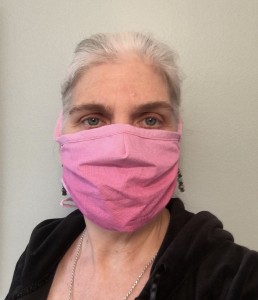When Covering Your Face, Consider the Science of Surgical Masks | CSUN Experts

Tracie Tung, CSUN Family and Consumer Sciences professor
The Centers for Disease Control and Prevention recently recommended people wear cloth face coverings in public settings. The virus that causes COVID-19 is known to spread from droplets in the air which come from an infected person who sneezes, coughs, breathes or talks.
In the days following this recommendation, people have begun making their own masks. These masks can help block the infected particles which make people sick with COVID-19.
There are many tutorials online now for making masks. The CDC has an article teaching people how to make masks. Feel free to look around online and find a tutorial that works for you.
I thought it would be helpful to explain the science of masks to help make better decisions in selecting fabrics for masks and know how to handle used masks.
How masks work
Medical masks are designed to physically capture airborne infected particles on the fibers of the mask fabrics.
In the current market, the masks most commonly seen are:
- N95 respirators
- Surgical masks
- Cloth masks

Homemade cotton mask. Photo courtesy of Jean O’Sullivan.
The main difference among these masks is their filtration efficiency. Any type of mask provides some level of protection. The N95 provides the most protection, and is designed for professional health care providers. They are not recommended for public use.
Researchers indicated that N95 respirators can filter out about 95 percent of the particles as small as 0.3 microns. The size of coronavirus is around 0.1 microns, but usually viruses are carried in droplets which could be larger than 20 microns.
The surgical mask can filter out about 60–80 percent of the 0.3-micron particles.
Using materials found at home, people can create a mask that is close to the surgical mask filtration level.
Structure of a surgical mask
A surgical mask consists of three layers and a metal strip at the top. Each layer exhibits specific functions to provide protection and comfort to the wearer.
- The outer layer: water-repellent, good air permeability, static property, dust prevention, sterilization
- The middle layer: pathogens filtration, good air permeability, static property, dust prevention, sterilization
- The inner layer: moisture absorbent, comfort
- The metal strip: fit enhancement, leakage prevention
The main purpose of the outer layer is to repel water, blood and other bodily fluids. This layer repels droplets and larger airborne particles that are released by talking, coughing and sneezing.
The middle layer of a surgical mask filters pathogens, serving as a barrier to smaller particles such as germs and viruses. Static electricity within the fibers of the outer and middle layers helps block particle transmission by attracting those particles to cling to the fibers.
The inner layer touches the wearer’s skin. Thus, while it absorbs moisture from the wearer, such as exhaled air and sweat, this layer needs to be soft and comfortable. Although each layer holds its specific function, all three layers provide good breathability so that wearers can wear the mask for long periods of time.
The effectiveness of cloth masks depends on the type of materials used. The higher the thread count, the better it will be at filtration.
Research on materials
Thread count is the number of threads woven together in a square inch, counting lengthwise and widthwise, and is commonly used in describing woven fabrics. The structure of a knit fabric (like a t-shirt fabric) is based on rows of interlocked loops. This systematic row-and-column arrangement and porous structure also make it difficult to capture all the particles that are smaller than the gaps among threads.
A simple analogy envisioning a tennis racket weave and sand can be used to explain how thread count works to trap airborne particles: The structure of a woven fabric is like a tennis racket, and sand is like airborne particles. In order to capture sand with the tennis racket, the sizes of holes between strings would need to be smaller than the grains of sand.
When the size of holes is bigger than sand grains, we need to add another layer to the racket to reduce the size of holes. Or we can add more strings to the racket to make a more compact net structure, i.e. increasing the thread count of a woven fabric.
A study conducted by Yang Wang at Missouri University of Science and Technology indicated that a mask made with a 600-thread count pillowcase captured only 22% of the particles. To capture about 60%, his team increased the pillowcase layers to four. (Note that this thick structure may also bring discomfort to the wearer.) A 400-thread count pillowcase performed less efficient than a 600-count one, Wang indicated. The rest of the comparison conducted in his study is listed below:
- 600-thread count fabric (one layer): 22% (filtration efficiency)
- 600-thread count fabric (four layer): 60% (filtration efficiency)
- A thick scarf (two layers): 21% (filtration efficiency)
- A thick scarf (four layers): 48.8% (filtration efficiency)
- 100% cotton bandanna (two layers): 18.2% (filtration efficiency)
- 100% cotton bandanna (four layers): 19.5% (filtration efficiency)
Material possibilities
Based on the structure of a surgical mask, possible materials to use in your mask include:
- The outer layer: Disposable nonwoven bed sheet used in clinics or beauty salons
- The middle layer: HVAC/HEPA filters (however, consumers should check fiber content for toxic materials, such as fiberglass)
- The inner layer: Cotton cloth, t-shirt
- The metal strip: Twist ties

Homemade cotton mask. Photo courtesy of Jean O’Sullivan.
The middle layer used in a surgical mask is a nonwoven fabric, so-called “fiberweb” structures. Among several techniques developed to form fiberweb structures, melt-blown is the one used to produce the surgical mask nonwoven fabrics. The arrangement of melt-blown fibers is random, thus creating a network of complications for any particles to permeate. They just can’t get through.
To achieve filtration efficiency close to surgical masks, consider adding polypropylene melt-blown nonwoven fabrics, which is the material used in surgical masks and have an electret quality which further provides statics to enable the fabric to capture the particles. Polypropylene (PP), also called olefin, is a petroleum-based fiber and is used in HVAC filters, FedEx white envelopes, and building materials such as Tyvek.
In this case, the homemade mask should have a built-in pocket allowing to replace the filter after every use.
In summary, an efficient mask needs to consist of the following characteristics:
- Convoluted pathways of the fiber arrangement
- Static property
- Good air permeability (breathable)
- Comfort (soft and lightweight)
- Water repellent
How to wear a mask
Any kind of mask is likely to decrease the transmission of airborne particles and lower infection risks. In addition, it is also important to wear and remove your mask correctly. Airborne particles are physically captured by the fibers and fabrics. Shaking the mask could result in the particles falling and adhering to the wearer’s clothes and other places. If the wearer touched those clothes or places and then touched his/her face or mouth, a mask would not provide the expected level of protection to the wearer.
In addition, fit factor is critical. Any gaps between the mask and the face will undermine the filtration efficiency. The N95 respiratory can provide a great fit to the wearer. It is so tight that when removing, it leaves a mask mark as those we see on many medical personnel’s faces. It is hard to achieve such good fit with a surgical or cloth mask. Thus, it is very important to 1) fully cover your nose and mouth when wearing a surgical and cloth mask and 2) to gently remove a used mask without touching your face, nose, eyes, and mouth, and wash hands right away.
A cloth mask should be washed after every use.
Sustainability concerns
Surgical masks and N95 respirators are made for one-time use. Because polypropylene is a petroleum-based material, the environmental impact resulted from disposed masks needs a further investigation.
Lastly, it is clear that most of the masks in the market do not exhibit 100% filtration efficiency. Thus, not only is wearing a mask to protect yourself and others important (some of the COVID-19 patient are asymptomatic carriers), but also keeping social distances and washing hands are much more critical. Staying at home and eliminating non-essential travel will save people and the planet.
Jason Lo contributed to this article.
About CSUN Experts
CSUN Experts is a series of articles written by CSUN faculty members who share insights and expertise about newsworthy events and issues. Faculty members who would like to pitch a CSUN Experts idea can email csuntoday@csun.edu.

 experience
experience